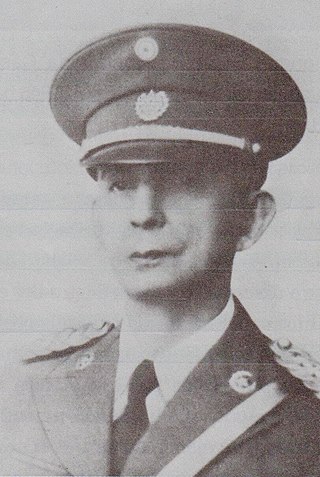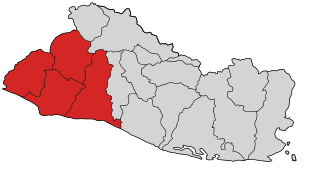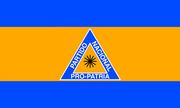The history of El Salvador begins with several distinct groups of Mesoamerican people, especially the Pipil, the Lenca and the Maya. In the early 16th century, the Spanish Empire conquered the territory, incorporating it into the Viceroyalty of New Spain ruled from Mexico City. In 1821, El Salvador achieved independence from Spain as part of the First Mexican Empire, only to further secede as part of the Federal Republic of Central America two years later. Upon the republic's independence in 1841, El Salvador became a sovereign state until forming a short-lived union with Honduras and Nicaragua called the Greater Republic of Central America, which lasted from 1895 to 1898.

Maximiliano Hernández Martínez was a Salvadoran military officer and politician who served as president of El Salvador from 4 December 1931 to 28 August 1934 in an provisional capacity and again in an official capacity from 1 March 1935 to his resignation on 9 May 1944. Martínez was the leader of El Salvador during most of World War II.

Osmín Aguirre y Salinas was a Salvadoran military officer and politician who served as the provisional president of El Salvador from 21 October 1944 until 1 March 1945. A Colonel in the Salvadoran Army, Aguirre y Salinas led two successful coups against the Salvadoran government: once in 1931 and once more in 1944. He left office in 1945, with the assurance that his successor in the next election would be Salvador Castaneda Castro. Aguirre y Salinas was later assassinated by left-wing guerrillas near his home in San Salvador at the age of 87.

Salvador Castaneda Castro was President of El Salvador from 1 March 1945 to 14 December 1948. He had previously served as Interior Minister under President Maximiliano Hernández Martínez. He was elected unopposed during martial law in January 1945, and was overthrown in a coup by other military officers in December 1948.

La Matanza refers to a communist-indigenous rebellion that took place in El Salvador between 22 and 25 January 1932. After the revolt was suppressed, it was followed by large-scale government killings in western El Salvador, which resulted in the deaths of 10,000 to 40,000 people. Another 100 soldiers were killed during the suppression of the revolt.

The Salvadoran military dictatorship was the period of time in Salvadoran history where the Salvadoran Armed Forces governed the country for almost 48 years from 2 December 1931 until 15 October 1979. The authoritarian military dictatorship limited political rights throughout the country and maintained its governance through rigged and fixed elections.

The People's Revolutionary Army was one of five leftist guerrilla organizations that comprised the Farabundo Martí National Liberation Front (FMLN). Formed on October 10, 1980, the FMLN was one of the main participants in the Salvadoran Civil War (1979-1992).

The Civic Directory was a military junta which governed El Salvador from 2 to 4 December 1931. The junta was composed of twelve members of the Armed Forces from the Army, Air Force, and National Guard. The directory marked the beginning of the era of military dictatorship in El Salvador which lasted until October 1979 with the 1979 coup d'état and the establishment of the Revolutionary Government Junta, a joint civilian-military government which ruled until 1982.

The 1931 Salvadoran coup d'état occurred on 2 December 1931. The coup overthrew President Arturo Araujo and led to the establishment of the Civic Directory. The coup began 48 years of military rule in El Salvador which lasted until the 1979 Salvadoran coup d'état.
The following lists events that happened in 1935 in El Salvador.
The following lists events that happened in 1938 in El Salvador.
The following lists events that happened in 1939 in El Salvador.
The following lists events that happened in 1944 in El Salvador.
The 1923 Central American Treaty of Peace and Amity, officially known as the General Treaty of Peace and Amity, 1923, was a treaty signed by the five nations of Central America in 1923 which established that all nations would denounce and not recognize any government which arose in any of the five signatory nations through illegal means. The treaty remained effective from its signing on 7 February 1923 until it was denounced by the Central American Court of Justice in 1934.
The Labor Party was a Salvadoran political party that existed from 1930 to 1931.
The National Republican Party was a Salvadoran political party that existed from 1930 to 1931.

The Palm Sunday Coup was an attempted military coup d'état in El Salvador which occurred in early-April 1944. The coup was staged by pro-Axis sympathizers in the Salvadoran Army against President General Maximiliano Hernández Martínez.
Anarchism in El Salvador reached its peak during the labour movement of the 1920s, in which anarcho-syndicalists played a leading role. The movement was subsequently suppressed by the military dictatorship before experiencing a resurgence in the 21st century.
Abraham Castillo Mora was a Salvadoran politician and military officer from Sonsonate who served as governor of the Ahuachapán and Sonsonate departments, as well as being a deputy of the Legislative Assembly of El Salvador for Sonsonate. He was involved in several land disputes during the late-1890s.









